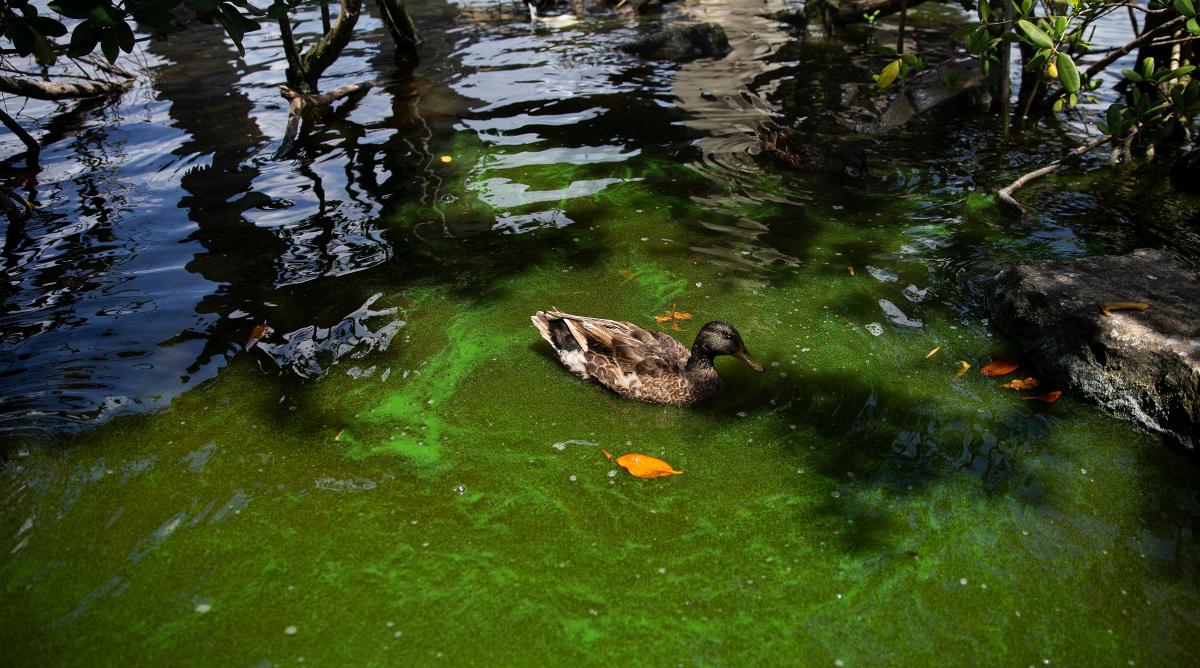BREVARD COUNTY, Fla. — A new federal report says more people and animals, including beloved pets, are getting sick from exposure to toxic algae that forms in natural waterbodies across the country.
While there have been no human deaths, animals have died from the toxic effects, the report shows.
Harmful algal blooms (HABs) seem to be becoming worse nationwide, especially during the summer. According to the Centers for Disease Control and Prevention’s new report that analyzes data from 2021, 16 states reported a total of 117 human illnesses and at least 2,715 animal illnesses as a result of HAB events.
HAB events peak in August, the report found, with 90% of blooms occurring in lakes, reservoirs and other fresh waters. HABs emerge from the rapid growth of algae or cyanobacteria — also known as blue-green algae, according to the CDC.
“HAB events of public health concern are primarily caused by microalgae (e.g., diatoms and dinoflagellates), cyanobacteria, and the toxins they can produce,” the CDC said in its report. “HAB events, which can be intensified by factors such as nutrient pollution and warmer water temperature, can have public health, environmental, and economic impacts.”
The CDC’s report is based on voluntary reporting by public health agencies and their designated environmental health or animal health partners.
In 2021, the CDC said 368 HAB events were reported by 16 state jurisdictions, which is a significant increase compared to previous years where less than 250 HAB events were reported in 2020 and 2019.
Exposure to high levels of blue-green algae and their toxins can cause illness and death, the CDC said. Several states have reported wildlife, domestic pet and livestock illnesses and deaths in recent years.
What did CDC find?
Human illnesses from toxic blue-green algae happened predominately in June, the CDC said. The most commonly reported symptoms were gastrointestinal, dermatologic, and generalized, such as headaches and fevers.
Of the 117 cases, the CDC said 46% of illnesses were among people younger than 18 years old, suggesting children and teens may be at higher risk of illness than adults. No deaths were reported.
Nearly all of the cases of human illness reported water as a source of exposure to HABs, according to the CDC. People were exposed to HABs predominately at public outdoor areas and beaches.
Animal illnesses occurred primarily in August and mostly involved wildlife, according to the CDC. Among the cases, the animals most affected were dogs, cattle and bats.
At least 2,715 animal cases of illness were reported in 2021 with 76% of wildlife cases classified as confirmed, 67% of domestic cases as probable and 60% of livestock cases as suspect, the CDC said. And 92% of the animals reported ill died.
Rotting seaweed, dead fish, no sand: Climate change threatens to ruin US beaches
What is blue-green algae?
Blue-green algae are a type of bacteria that is common in freshwater environments. A bloom occurs when rapid growth of algae leads to an accumulation of individual cells that discolor water and often produce floating mats that emit unpleasant odors.
Some environmental factors that contribute to blue-green algae blooms are sunny days, warm water temperatures, still water conditions and excess nutrients. Blooms can appear year-round but are more frequent in summer and fall. Many types of blue-green algae can produce toxins.
How is it harmful?
Blue-green algae blooms can impact human health and ecosystems, including fish and other aquatic animals.
Public health officials have said exposure to high levels of blue-green algae and their toxins can cause illnesses, including diarrhea, nausea or vomiting; skin, eye or throat irritation; and allergic reactions or breathing difficulties.
Pets and livestock can also get sick or die if they consume large amounts of water containing blooms, scums or benthic mats.
Southern California algae bloom: Toxic algae bloom suspected in deaths of sea lions and dolphins on Southern California coast
Reported cases nationwide
Blue-green algae blooms have been observed across the United States. Some cases have triggered health officials to warn visitors and residents to not swim, wade, boat, eat fish, or let pets sip water from different bodies of water.
In its report, the CDC said a large wildlife mortality event occurred in Washington from a single harmful algae bloom and involved at least 2,000 bats. This was the largest bat die-off linked to a harmful algae bloom ever reported to the CDC.
Last week, Kansas health officials reported that nine state lakes were impacted by blue-green algae and issued several types of advisories for those areas.
The toxic algae has also plagued Florida waterways for years, thriving on excess nitrogen and phosphorus from fertilizers, septic tanks and sewage spills. Several Florida dogs have gotten sick or died from drinking water laden with toxic blue-green algae in recent years.
In 2021, Bella, an 8-year-old boxer died after she ate toxin-laced detritus from a canal, marking her as possibly the first reported canine death in Palm Beach County from blue-green algae poisoning. In 2018, six dogs got sick from blue-green algae in the St. Lucie River, one fatally.
This article originally appeared on USA TODAY NETWORK: CDC report: Toxic algae are causing illnesses in people, pets
